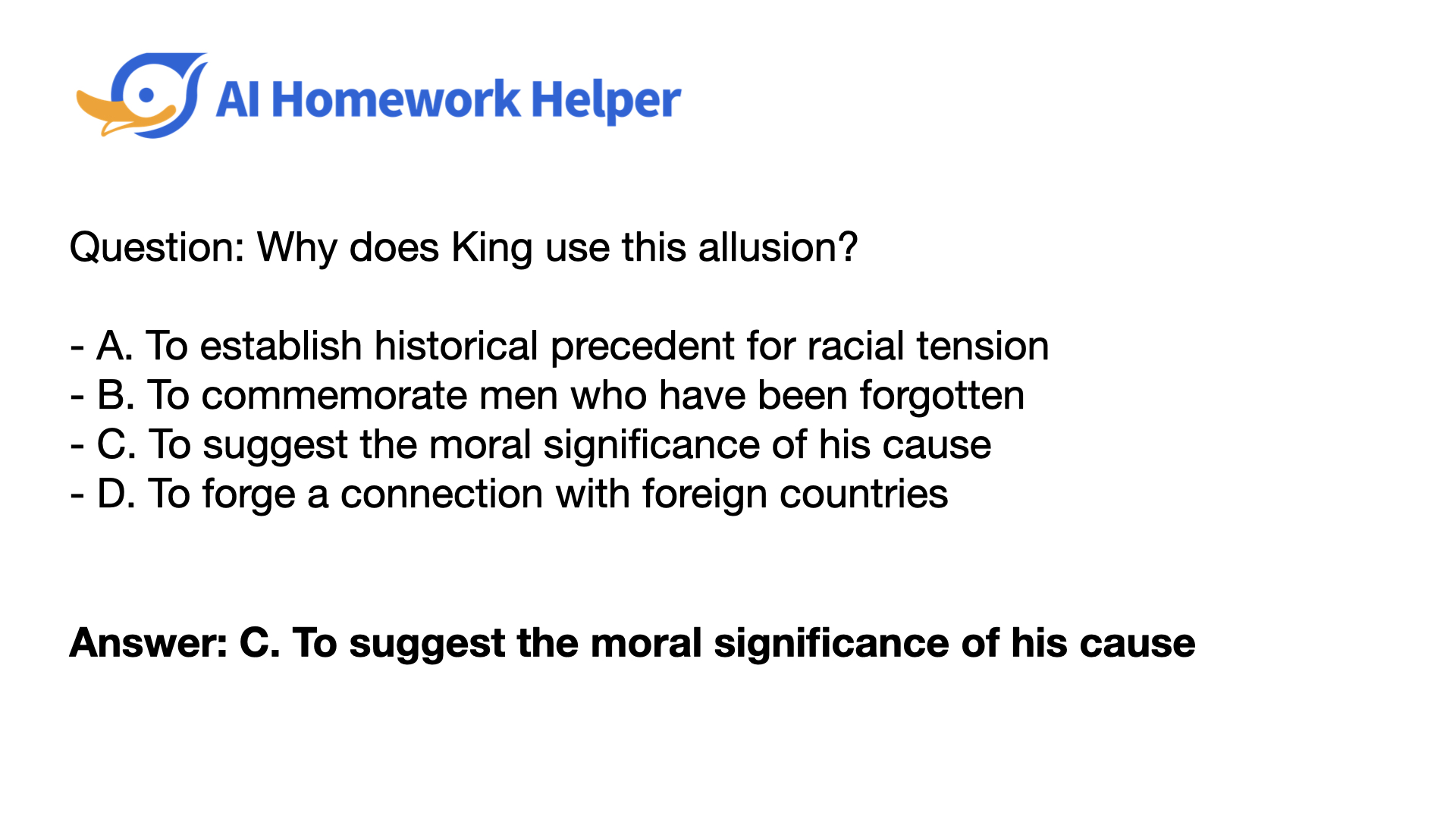
Why does King use this allusion?
Question: Why does King use this allusion?
- A. To establish historical precedent for racial tension
- B. To commemorate men who have been forgotten
- C. To suggest the moral significance of his cause
- D. To forge a connection with foreign countries
Answer: C. To suggest the moral significance of his cause
Brief Explanation:
Option C: To suggest the moral significance of his cause is the correct answer. Martin Luther King Jr. frequently employed allusions in his speeches to highlight the ethical and moral foundations of the civil rights movement. By referencing historical events, revered figures, and foundational documents, King reinforced the righteousness and ethical imperative of striving for racial equality and justice.
Detailed Explanation:
Understanding Allusions in King's Speeches
An allusion is a literary device where the author references a well-known person, event, place, or work of art to add deeper meaning to their message. Martin Luther King Jr. masterfully used allusions to connect the civil rights struggle to broader historical and moral contexts.
Option Analysis:
-
A. To establish historical precedent for racial tension
While King did reference historical racial injustices to illustrate ongoing struggles, the primary purpose was not merely to establish precedent but to underscore the enduring need for justice and equality. -
B. To commemorate men who have been forgotten
Although King honored the contributions of many unsung heroes, this was a secondary objective. The central aim was to draw attention to the moral imperatives driving the movement. -
C. To suggest the moral significance of his cause
Correct Choice. By alluding to pivotal moments in history, like the Emancipation Proclamation or the Declaration of Independence, King emphasized that the fight for civil rights was not only a political or social endeavor but a profound moral necessity. These references served to position the civil rights movement within the larger narrative of American values and ethical principles. -
D. To forge a connection with foreign countries
While King's message had universal themes that resonated globally, his primary intent with allusions was to ground his arguments in a shared moral and historical framework rather than to directly connect with foreign nations.
Examples of King's Use of Allusion:
-
"I Have a Dream" Speech:
- Emancipation Proclamation: King references this landmark executive order to highlight the unfulfilled promises of freedom and equality for African Americans.
- Declaration of Independence: By invoking the foundational American document, King stressed that racial equality was inherently linked to the nation's core values.
-
"Letter from Birmingham Jail":
- Socrates and Shylock: King uses literary allusions to illustrate points about justice, morality, and ethical responsibility, reinforcing the righteousness of nonviolent protest.
Impact of These Allusions:
-
Moral Authority: By aligning the civil rights movement with revered historical and moral benchmarks, King lent his cause greater legitimacy and ethical weight.
-
Emotional Resonance: Allusions helped listeners draw parallels between familiar historical narratives and contemporary struggles, deepening emotional engagement and commitment.
-
Unified Vision: Referencing shared history and values fostered a sense of unity and collective purpose among diverse audiences, both within the United States and internationally.
Conclusion:
Martin Luther King Jr.'s strategic use of allusions was pivotal in articulating the moral foundation of the civil rights movement. By connecting his cause to well-established historical and ethical frameworks, King not only justified the necessity for change but also inspired a broad coalition of supporters to join in the pursuit of justice and equality.